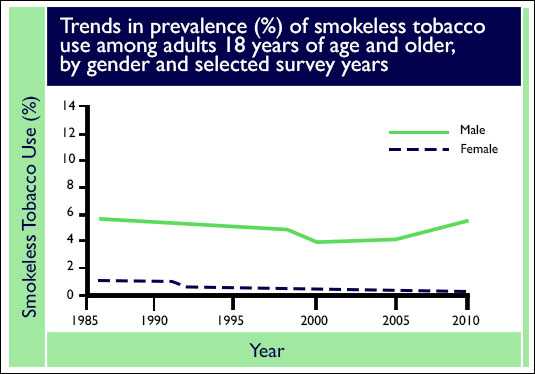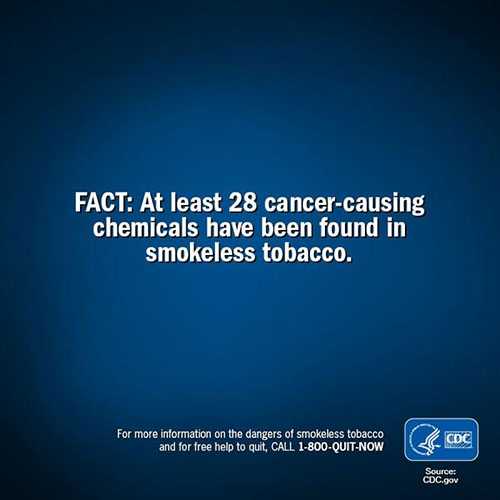Smokeless Tobacco Use in the United States
This fact sheet provides the latest data and information on how many people use smokeless and other tobacco products and what is being done to protect the public's health from the harmful effects of smokeless tobacco use.
Smokeless tobacco is not a safe alternative to smoking. Learn more about who uses it and what measures are in place to protect the public's health.
Adult Smokeless Tobacco Use (National)
As shown in the graph below, smokeless tobacco use among females has remained low throughout the years. Among males, use decreased during 1986-2000 but has been increasing since then.1

Percentage of Adults Who Were Current Smokeless Tobacco Users in 20142
- Adults aged 18 years and older: more than 3 in every 100 (3.4%)
- Men: nearly 7 in every 100 (6.7%)
- Women: fewer than 1 in every 100 (0.3%)
- Non-Hispanic African Americans: more than 1 in every 100 (1.2%)
- Non-Hispanic American Indians/Alaska Natives: more than 7 in every 100 (7.1%)
- Non-Hispanic Asians: fewer than 1 in every 100 (0.6%)
- Hispanics: fewer than 1 in every 100 (0.9%)
- Non-Hispanic Whites: nearly 5 in every 100 (4.6%)
NOTE:
In the list above, "current smokeless tobacco use" means using chewing tobacco or snuff on 1 or more of the 30 days before participation in a survey about this topic. Dissolvable tobacco, dip, and U.S. snus were not measured. Survey was conducted among persons aged 18 and older.
Adult Smokeless Tobacco Use (State-Specific)
- In 2014, current smokeless tobacco use was highest in:3
- Wyoming: nearly 9 in every 100 people (8.8%)
- West Virginia: nearly 9 in every 100 people (8.5%)
- Montana: nearly 8 in every 100 people (7.6%)
- Mississippi: more than 7 in every 100 people (7.5%)
- In 2014, current smokeless tobacco use was lowest in:3
- Delaware, Hawaii and Massachusetts: more than 1 in every 100 people (1.5%)
- California: more than 1 in every 100 people (1.6%)
- Connecticut and Maryland: nearly 2 in every 100 people (1.8%)
NOTE:
- In the list above, "current smokeless tobacco" means using chewing tobacco, snuff, or snus every day or some days at the time of the survey.
- In the District of Columbia nearly 2 in every 100 people used smokeless tobacco some days at the time of the survey; however, estimates are not available for those who used smokeless tobacco every day at the time of the survey.
Youth Smokeless Tobacco Use
The table below shows the percentage of high school students who were current users of smokeless tobacco in 2015.

| High School Students in 20154 | Current Use of Smokeless Tobacco |
|---|---|
| Overall | 6.0% |
| Males | 10.0% |
| Females | 1.8% |
| White non-Hispanic | 7.8% |
| Black non-Hispanic | 1.9% |
| Hispanic | 3.1% |
NOTE:
In the table above—
- Percentages represent approximately how many people in every 100 people use smokeless tobacco products. For example, 7.8% represents more than 7 in every 100 people.
- "Current use of smokeless tobacco use" means using chewing tobacco, snuff, dip, snus, or dissolvable tobacco on 1 or more of the 30 days before participation in a survey about this topic.
Multiple Product Use
According to the 2012 National Survey on Drug Use and Health:1
- About 1 in every 100 youth aged 12–17 years (1.1%) and nearly 4 in every 100 young adults aged 18–25 years (3.9%) were current users of smokeless tobacco and at least one other tobacco product.
- About 1 in every 100 adults aged 26 years or older (1.2%) were current users of smokeless tobacco and at least one other tobacco product.
Measures to Protect the Public's Health
Family Smoking Prevention and Tobacco Control Act
In 2009, the Family Smoking Prevention and Tobacco Control Act (FSPTCA) gave the U.S. Food and Drug Administration (FDA) the authority to regulate the manufacture, distribution, and marketing of tobacco products, including smokeless tobacco. Among other restrictions, the FSPTCA:5
- Requires smokeless tobacco packages and advertisements to have larger and more visible labels that warn of health effects. Every package must include the following warning:
- This product can cause mouth cancer.
- This product can cause gum disease and tooth loss.
- This product is not a safe alternative to cigarettes.
- Smokeless tobacco is addictive.
- Prohibits the sale of smokeless tobacco in vending machines, except in adult-only facilities.
- Restricts tobacco marketing and sales to youth.
- Prohibits tobacco companies from making reduced-harm claims like “light,” “low,” or “mild” without approval from FDA.
- Requires tobacco companies to provide detailed information to FDA about the ingredients in their products.
FACT: At least 28 cancer-causing chemicals have been found in smokeless tobacco.
Larger infographic
References
- U.S. Department of Health and Human Services. The Health Consequences of Smoking—50 Years of Progress: A Report of the Surgeon General. Atlanta: U.S. Department of Health and Human Services, Centers for Disease Control and Prevention, National Center for Chronic Disease Prevention and Health Promotion, Office on Smoking and Health, 2014 [accessed 2016 Jul 18].
- Center for Behavioral Health Statistics and Quality. 2014 National Survey on Drug Use and Health: Detailed Tables. Substance Abuse and Mental Health Services Administration, 2015, Rockville, MD [accessed 2016 Jul 18].
- Centers for Disease Control and Prevention. Behavioral Risk Factor Surveillance System: Prevalence and Trends Data. [accessed 2016 Jul 18].
- Centers for Disease Control and Prevention. Tobacco Use Among Middle and High School Students—United States, 2011-2015. Morbidity and Mortality Weekly Report 2016;65(14):361–7 [accessed 2016 Jul 18].
- U.S. Food and Drug Administration. Tobacco Control Act. U.S. Department of Health and Human Services, U.S. Food and Drug Administration, 2015 [accessed 2016 Jul 18].
For Further Information
Centers for Disease Control and Prevention
National Center for Chronic Disease Prevention and Health Promotion
Office on Smoking and Health
E-mail: tobaccoinfo@cdc.gov
Phone: 1-800-CDC-INFO
Media Inquiries: Contact CDC's Office on Smoking and Health press line at 770-488-5493.
- Page last reviewed: July 25, 2016
- Page last updated: July 25, 2016
- Content source:


 ShareCompartir
ShareCompartir
